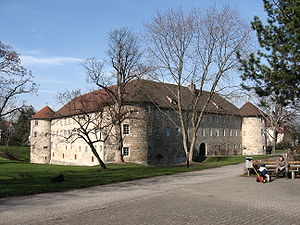Schorndorf Castle

The Schorndorf Castle is the remainder of an elaborate fortress from the Renaissance and stands on the edge of the old town of Schorndorf .
location
The castle stands southeast of the old town of Schorndorf. It is bordered by a green area, the palace garden . To the west of the castle is the archive square with the old hospital and the city archive; further east is the park at the Stadthallensee with the former Villa Arnold , which is now the adult education center. To the south-east are the Feuersee and the Heilig-Geist-Kirche. The hunting lodge is directly opposite .
history
Under Duke Ulrich (1498–1550), Schorndorf Castle was built from 1538, probably on the site of an older moated castle. In addition to the fortifications of Hohenneuffen , Hohenurach , Hohenasperg , Hohentwiel and the city fortresses Schorndorf and Kirchheim (Teck), it was to serve as a state fortress. In the 16th century Schorndorf was the strongest city fortress in the entire duchy. The castle was the cornerstone of the city fortress, which was built at great expense, and survived all storms, including the conflagration of 1634, which otherwise fell victim to almost the entire city.
The castle had a permanent occupation and also contained some royal apartments, from which the name “castle castle” could come.
In the 19th century, various alterations were made to the castle; so it served briefly as a barracks from 1801 to 1804 . Around 1834 a prison and various civil servants' apartments were also built.
The moat that surrounds the castle was initially partially and later completely filled in in 1837; In 1976 the trench was dug again and the plinth was exposed again. Today various authorities such as the district court are housed in the fortress.
Structure and special features
The castle consists of a trapezoidal four-wing complex with mighty round towers at the corners. The small, rectangular inner courtyard of the simple Renaissance building is constructed from half-timbering . The inscriptions and elaborately designed coats of arms on the towers and above the two entrances to the castle courtyard are worth seeing; A cast bay window is emblazoned above the main portal .
Historical issue
Due to the ambivalent appearance of the castle, the transition from castle to castle , which is based on the inner courtyard, which is very light and fragile with half-timbering , some historians have viewed the original function as part of the fortress critically or rejected it entirely. Edeltraud Geiger is of the opinion that the castle was originally a citadel , the outer fronts of which initially only had loopholes .
According to Wolfgang Morlok, the former head of the Schorndorfer City Museum, the interior of the castle was "far too vulnerable" for fortification functions. From this he concludes that despite its brawny appearance today, the castle was not part of the defensive system from the start. The thesis is supported by the fortress plan from 1730, as it does not contain the castle.
Hunting lodge
The hunting lodge, which is opposite the main entrance of the castle, was built in 1555 by Duke Christoph . It used to be known as the New Palace. Later it was the residence of Obervogt , from 1755 to the financial officials in the New Castle is located.
From 1810 it was used as a hunting lodge for King Friedrich , who liked to hunt in the surrounding forests. The forestry office was housed here from 1817, today it is the seat of the tax office.
literature
- Alois Schneider: From a major military project to an archaeological cultural monument. The demolition of the Württemberg state fortress Schorndorf in the 19th century . In: Preservation of monuments in Baden-Württemberg , 41st year 2012, issue 4, pp. 212–217. ( PDF )
- History of the city of Schorndorf. Konrad Theiss Verlag, Stuttgart 2002.
- Gerhard Fritz, Roland Schurig (ed.): The castles in the Rems-Murr-Kreis . Manfred Hennecke Verlag, Remshalden 1994, ISBN 3-927981-42-7 , pp. 98-102.
Web links
- The castle on stuttgart-tourist.de
- The castle castle on the official website of the city of Schorndorf
See also
Coordinates: 48 ° 48 ′ 15.7 " N , 9 ° 31 ′ 48" E


